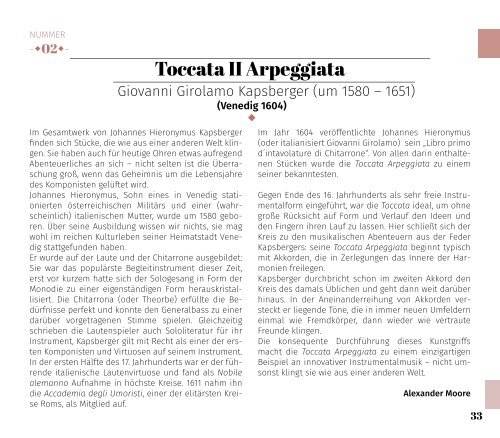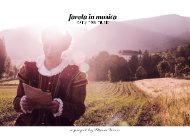Booklet "favola in musica.alte neue musik"
Enjoy the 216 pages fairy tale book inspired booklet of "favola in musica. early new music" in German and English with over 100 photographs, well researched musical texts to each aria, translations of all aria texts in German and English and biographies of all participating members. Music from renaissance, baroque and present time - 3 world premiere recordings from early music (Antonio Caldara, Sebastian Durón) - 2 world premiere recordings of contemporary music (Wolfgang Mitterer) - 1 bonus music-video (included on the CD) Deluxe Edition in a high-quality CD-Hardcover-Digibook, 216 costly designed pages with photos and texts 1607. ensemble for early & new music: Maria Weiss, voice, artistic director Rosario Conte, theorbo Gyöngy Erödi, cello Wolfgang Mitterer, composer Awarded the Pasticciopreis 2015 in Radio Österreich 1 »favola in musica« (eng. fairy tale in music) is the debut-album of the mezzo-soprano Maria Weiss, who designed this album as a musical fairy taie. It is the searching for the New within the Old and for the Old within the New. Developing this album,Maria Weiss lifted some treasures to light, so e.g. she discovered in the archives an aria of the forgotten opera of the composer Antonio Caldara. She also asked the composer and performer Wolfgang Mitterer, to reate two new works for this album. If you engage into this musical journey, you can also find the words of Monteverdis L'Orfeo but in an competely new contemporary way. Enjoy!
Enjoy the 216 pages fairy tale book inspired booklet of "favola in musica. early new music" in German and English with over 100 photographs, well researched musical texts to each aria, translations of all aria texts in German and English and biographies of all participating members.
Music from renaissance, baroque and present time
- 3 world premiere recordings from early music (Antonio Caldara, Sebastian Durón)
- 2 world premiere recordings of contemporary music (Wolfgang Mitterer)
- 1 bonus music-video (included on the CD)
Deluxe Edition in a high-quality CD-Hardcover-Digibook, 216 costly designed pages with photos and texts
1607. ensemble for early & new music:
Maria Weiss, voice, artistic director
Rosario Conte, theorbo
Gyöngy Erödi, cello
Wolfgang Mitterer, composer
Awarded the Pasticciopreis 2015 in Radio Österreich 1
»favola in musica« (eng. fairy tale in music) is the debut-album of the mezzo-soprano Maria Weiss, who designed this album as a musical fairy taie. It is the searching for the New within the Old and for the Old within the New. Developing this album,Maria Weiss lifted some treasures to light, so e.g. she discovered in the archives an aria of the forgotten opera of the composer Antonio Caldara. She also asked the composer and performer Wolfgang Mitterer, to reate two new works for this album. If you engage into this musical journey, you can also find the words of Monteverdis L'Orfeo but in an competely new contemporary way. Enjoy!
Erfolgreiche ePaper selbst erstellen
Machen Sie aus Ihren PDF Publikationen ein blätterbares Flipbook mit unserer einzigartigen Google optimierten e-Paper Software.
NUMMER<br />
-•02•-<br />
Toccata II Arpeggiata<br />
Giovanni Girolamo Kapsberger (um 1580 – 1651)<br />
(Venedig 1604)<br />
•<br />
Im Gesamtwerk von Johannes Hieronymus Kapsberger<br />
f<strong>in</strong>den sich Stücke, die wie aus e<strong>in</strong>er anderen Welt kl<strong>in</strong>gen.<br />
Sie haben auch für heutige Ohren etwas aufregend<br />
Abenteuerliches an sich – nicht selten ist die Überraschung<br />
groß, wenn das Geheimnis um die Lebensjahre<br />
des Komponisten gelüftet wird.<br />
Johannes Hieronymus, Sohn e<strong>in</strong>es <strong>in</strong> Venedig stationierten<br />
österreichischen Militärs und e<strong>in</strong>er (wahrsche<strong>in</strong>lich)<br />
italienischen Mutter, wurde um 1580 geboren.<br />
Über se<strong>in</strong>e Ausbildung wissen wir nichts, sie mag<br />
wohl im reichen Kulturleben se<strong>in</strong>er Heimatstadt Venedig<br />
stattgefunden haben.<br />
Er wurde auf der Laute und der Chitarrone ausgebildet:<br />
Sie war das populärste Begleit<strong>in</strong>strument dieser Zeit,<br />
erst vor kurzem hatte sich der Sologesang <strong>in</strong> Form der<br />
Monodie zu e<strong>in</strong>er eigenständigen Form herauskristallisiert.<br />
Die Chitarrona (oder Theorbe) erfüllte die Bedürfnisse<br />
perfekt und konnte den Generalbass zu e<strong>in</strong>er<br />
darüber vorgetragenen Stimme spielen. Gleichzeitig<br />
schrieben die Lautenspieler auch Sololiteratur für ihr<br />
Instrument, Kapsberger gilt mit Recht als e<strong>in</strong>er der ersten<br />
Komponisten und Virtuosen auf se<strong>in</strong>em Instrument.<br />
In der ersten Hälfte des 17. Jahrhunderts war er der führende<br />
italienische Lautenvirtuose und fand als Nobile<br />
alemanno Aufnahme <strong>in</strong> höchste Kreise. 1611 nahm ihn<br />
die Accademia degli Umoristi, e<strong>in</strong>er der elitärsten Kreise<br />
Roms, als Mitglied auf.<br />
Im Jahr 1604 veröffentlichte Johannes Hieronymus<br />
(oder italianisiert Giovanni Girolamo) se<strong>in</strong> „Libro primo<br />
d´<strong>in</strong>tavolature di Chitarrone“. Von allen dar<strong>in</strong> enth<strong>alte</strong>nen<br />
Stücken wurde die Toccata Arpeggiata zu e<strong>in</strong>em<br />
se<strong>in</strong>er bekanntesten.<br />
Gegen Ende des 16. Jahrhunderts als sehr freie Instrumentalform<br />
e<strong>in</strong>geführt, war die Toccata ideal, um ohne<br />
große Rücksicht auf Form und Verlauf den Ideen und<br />
den F<strong>in</strong>gern ihren Lauf zu lassen. Hier schließt sich der<br />
Kreis zu den musikalischen Abenteuern aus der Feder<br />
Kapsbergers: se<strong>in</strong>e Toccata Arpeggiata beg<strong>in</strong>nt typisch<br />
mit Akkorden, die <strong>in</strong> Zerlegungen das Innere der Harmonien<br />
freilegen.<br />
Kapsberger durchbricht schon im zweiten Akkord den<br />
Kreis des damals Üblichen und geht dann weit darüber<br />
h<strong>in</strong>aus. In der Ane<strong>in</strong>anderreihung von Akkorden versteckt<br />
er liegende Töne, die <strong>in</strong> immer <strong>neue</strong>n Umfeldern<br />
e<strong>in</strong>mal wie Fremdkörper, dann wieder wie vertraute<br />
Freunde kl<strong>in</strong>gen.<br />
Die konsequente Durchführung dieses Kunstgriffs<br />
macht die Toccata Arpeggiata zu e<strong>in</strong>em e<strong>in</strong>zigartigen<br />
Beispiel an <strong>in</strong>novativer Instrumentalmusik – nicht umsonst<br />
kl<strong>in</strong>gt sie wie aus e<strong>in</strong>er anderen Welt.<br />
Alexander Moore<br />
33





